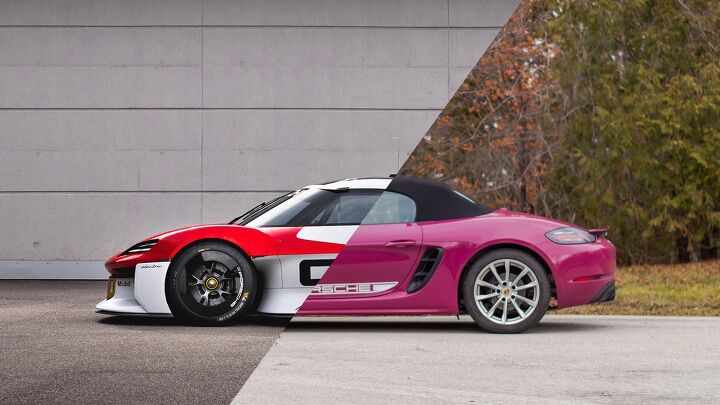I’m Ready for the Porsche 718 Boxster to Go All-Electric

The irony is not lost on me.
It’s early December, and the Porsche 718 Boxster Style Edition’s pink nose has been pointing north for nearly two hours. This was a very intentional scheduling, one done to showcase how well a droptop sports car can handle winter. Except winter never really came to Toronto, so with intermittent grumbling about climate change, I’m burning up half a tank of gas to drive hours north simply to hunt some snow.
While I enjoyed my time with the 718 Boxster Style Edition, it felt like the final chapter of a good book. Porsche has already confirmed that the next generation of its mid-engined sports car is going electric. While there are reasons to be apprehensive about the change—like the death of the manual transmission, for instance—there are a whole bunch more to look forward to an e-Boxster (and e-Cayman).
The fours are just fine
Ever since Porsche’s baby dropped two cylinders and gained the 718 designation in 2016, there’s been much gnashing of teeth from the peanut gallery. The downsizing trend is fine in most segments, but a two-door convertible? That’s supposed to be all about emotion, and RandomUser33486 swears the turbo-four strips this drop-top of its soul.
Further complicating matters, even Porsche pulled an about-face by bringing back a flat-six option a few years back; first in delicious Spyder and GT4 form, then in the GTS 4.0 variants. In fact, according to Porsche Canada, just 25 percent of all 718s sold in 2023 were powered by the flat-fours. The people, it seems, have spoken. But the nat-asp six can’t continue forever: it couldn’t in the 911, outside of the GT3 and its assorted, related special editions. Turbos are the internal combustion engine’s lifeline.
The Style Edition uses the smaller 2.0-liter turbo unit, and you know what? It’s fine. Plenty enough power to have fun—more than any Boxster had for the first decade of the model’s existence—and with surprisingly good fuel economy. Is the engine note a little… industrial? Yes. The flat-four sounds how a can of Red Bull tastes: like it works. A sufficiently well-engineered electric drivetrain can provide much of the same experience, and with a selectable soundtrack.
The harder goodbye is certainly the three-pedal setup. It’s a hit with current buyers: 41 percent of last year’s sales were manuals. We here at AutoGuide get it: not only is a manual more engaging, but Porsche’s is a sweet one. The Germans aren’t pulling a Toyota by developing an EV manual, either. "What we want, and that's the key for Porsche, is to make it authentic,” told The Drive, “So therefore, I don't know that there's a way for us to have a stick-shift in an electrified car."
Nobody is doing it
Take a look at the EV landscape. A whole bunch of family-sized crossovers, a peppering of sedans, and a select few trucks. That’s about it.
Porsche has an opportunity to plant a flag in a segment nice and early. With Elon more focused on picking fights on the social media platform he paid billions to destroy than delivering on the Roadster 2.0 he promised six years ago, Stuttgart could have the first real, modern EV sports car. And who knows better about sports cars than Porsche? EVs have a few inherent design advantages keen drivers will enjoy too, such as a low center of gravity and responsive powertrain. Part of the magic in the 718 experience is the low-slung nature and the low polar moment of inertia. An electrified Boxster is very likely to match, if not beat, the current car’s tight concentration of its weight between the axles. The building blocks are there for a sweet chassis balance.
No longer held back by 911
Perhaps the most fascinating aspect of an e-718 is that it will no longer have to sit below the 911. It’s unlikely to eclipse the family icon, of course, but a zero-emission 718 pair can co-exist alongside its big brother, targeting different sports car buyers.
The company is currently targeting a curb weight of just 3,650 pounds (1,655 kilograms); chunky compared to the modern 718, but very light by EV standards. That’s an entire person less than a 911 Turbo S, too. That curb weight is likely to be a single-motor variant, but even a dual-motor setup would only have a slight weight penalty. Yes, two motors means the first all-wheel drive 718; that’s not something that ever could’ve happened in the ICE days.
Pricing will also shift the EV 718 closer to its brother: Porsche’s head of finance pegged it at 15 percent more expensive, as reported by Motor1.
It’s time
The car that helped save Porsche in the ‘90s has nothing left to prove. The 718 Boxster and Cayman have evolved into some of the best-driving sports cars on the market, ranging from the design-focused Style Editions to the barely-a-road-car GT4 RS. 31 years on from the original concept, it’s time for a new challenge: to set the bar for driver engagement in the EV era. I can’t wait to see what Porsche has cooked up.
Become an AutoGuide insider. Get the latest from the automotive world first by subscribing to our newsletter here.

Kyle began his automotive obsession before he even started school, courtesy of a remote control Porsche and various LEGO sets. He later studied advertising and graphic design at Humber College, which led him to writing about cars (both real and digital). He is now a proud member of the Automobile Journalists Association of Canada (AJAC), where he was the Journalist of the Year runner-up for 2021.
More by Kyle Patrick



































Comments
Join the conversation
A Boxter that goes whoosh. No, thanks.
The current 718 4 banger has the most gawd awful sound when the throttle is pushed. Will be very interested to hear how the upcoming e version sounds.